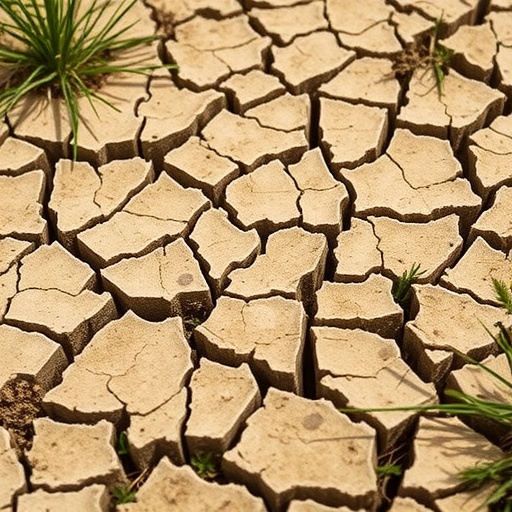In the face of escalating climate change-induced droughts, new research has illuminated the vulnerabilities of grassland and shrubland ecosystems worldwide. While these ecosystems have demonstrated some capacity to acclimatize to moderate drought conditions, the study reveals a stark limitation in their ability to withstand prolonged extreme dryness. An international research collaboration, featuring scientists from Murdoch University, conducted an unprecedented global analysis spanning 74 grasslands and shrublands, providing vital insights into how drought intensity and duration synergistically impair ecosystem productivity. Their findings sound a pressing alarm for the ecological balance and functionality of these vast terrestrial biomes.
Grasslands and shrublands account for nearly 40% of the Earth’s land surface, playing indispensable roles in carbon sequestration, habitat provision, and soil conservation. The resilience of these ecosystems to environmental stresses like drought has been a scientific focus, particularly given the increasing frequency of extreme climatic events. Previous studies have shown that moderate droughts allow for ecosystem acclimation and often stabilize productivity after initial declines. However, this comprehensive global investigation exposes a far more troubling dynamic when droughts become both severe and persistent.
The research, recently published in the prestigious journal Science, utilized rigorous data and statistical analyses to measure the impacts of varying drought intensities over multiple years. The study leverages an experimental approach known as the International Drought Experiment, which employs rainout shelters to simulate decreased rainfall scenarios across diverse global locations. This method provides robust, comparable datasets elucidating how ecosystems respond to controlled drought conditions. The Murdoch University team, led by Professor Rachel Standish, contributed key findings from their experimental site near Coolgardie in Western Australia.
One of the most alarming discoveries is the dramatic reduction in primary productivity under consecutive years of extreme drought stress. While moderate drought conditions initially reduce plant growth, ecosystems showed signs of recovery or stabilization by the second or third year. Contrarily, extreme drought conditions caused a cumulative decline in productivity, reaching a staggering 77% reduction by the fourth year. This decline indicates a breakdown in the ecosystems’ adaptive mechanisms, signaling a tipping point beyond which recovery is severely compromised or impossible.
From a mechanistic perspective, extreme and prolonged drought imposes severe water deficits that disrupt photosynthesis, nutrient uptake, and overall plant physiological functions. The study underscores the interaction between drought intensity—the severity of water deficit—and duration—the length of the drought period—as multiplicative factors that exacerbate stress beyond singular effects. This interaction amplifies vulnerabilities in plant communities, including reduced biomass accumulation, altered species composition, and diminished ecosystem services such as carbon uptake.
The implications extend far beyond local vegetation dynamics. Grassland and shrubland degradation under extreme drought conditions threatens to alter global biogeochemical cycles. Reduced primary productivity translates to diminished carbon sequestration capacity, potentially accelerating atmospheric CO2 accumulation and exacerbating climate change feedback loops. In addition, the loss of vegetation cover can increase soil erosion, disrupt hydrological cycles, and reduce biodiversity, with cascading effects on ecosystem resilience and human livelihoods dependent on these landscapes.
Professor Rachel Standish highlights the urgent need for incorporating these insights into climate adaptation strategies. “The future of these ecosystems is precarious as extreme droughts become more frequent and persistent due to climate change,” she asserts. Her team’s findings call for more in-depth investigations into the thresholds at which ecosystems transition from resilience to irreversible degradation, facilitating the development of predictive models that can inform mitigation efforts.
The International Drought Experiment embodies a significant collaborative effort, uniting researchers across continents to comprehensively evaluate drought responses in various biomes. This global approach addresses the heterogeneity of ecosystems, encompassing variations in soil type, climate zones, plant species, and land management practices. The experiment’s uniform methodology allows comparisons that were previously unattainable, reinforcing the robustness of the conclusions drawn.
Beyond the scientific community, this research carries critical messages for policymakers and environmental managers. The evidence necessitates urgent prioritization of drought mitigation measures that encompass ecosystem conservation, water management, and restoration practices tailored to the anticipated increase in drought frequency and severity. Notably, the study raises concerns about the limits of natural adaptive capacity and the potential need for active intervention to safeguard the ecological functions of grasslands and shrublands.
Moreover, the study contributes to a growing body of literature emphasizing the complexity of climate impacts on terrestrial ecosystems. Its nuanced understanding of interactive stressors challenges simplistic assessments of ecosystem resilience and underscores the value of integrating multifactorial stress analyses in ecological forecasting. These findings advocate for adaptive management frameworks underpinned by empirical data that reflect the realities of prolonging and intensifying droughts.
In conclusion, the research delivered by this international consortium represents a critical advancement in understanding how drought patterns modulate terrestrial ecosystem productivity. The compelling evidence that consecutive severe droughts precipitously undermine grassland and shrubland functionality serves as an urgent call for intensified global efforts to address climate change impacts. Protecting these expansive ecosystems is crucial not only for biodiversity conservation but also for sustaining ecosystem services integral to human well-being and planetary health.
Subject of Research: Not applicable
Article Title: Drought intensity and duration interact to magnify losses in primary productivity
News Publication Date: 16-Oct-2025
Web References:
– Full study: http://www.science.org/doi/10.1126/science.ads8144
– DOI: http://dx.doi.org/10.1126/science.ads8144
Image Credits: Professor Rachel Standish from Murdoch University
Keywords: Climate change effects, Droughts




